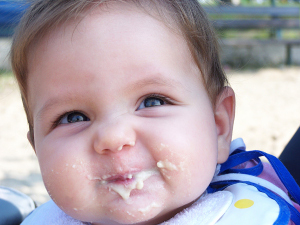If you’re planning on making your own baby food, you’ve probably read, or at least heard of, Ruth Yaron’s Super Baby Food. It’s a great guide: informative, detailed, well-researched–and also overwhelming. It’s easy to come away with the impression that making your own baby food is super difficult and requires sterile utensils and surgeon’s masks, but it’s not. Ms. Yaron researched her book thoroughly, that’s for sure. She also has a lot of tips and tricks to help new baby food makers. There is a great deal of extraneous information such as recipes for crackers and soy milk, and while helpful, it distracts and detracts from the main purpose of the book. The book could easily be broken down into three or four informative books instead of drowning the reader in an information overload. I’m an experienced super baby food maker and I’m here to demystify the book and the baby food making process for you. It’s much easier than it seems, I promise.
After reading Super Baby Food, you’re probably wondering how in the world you’ll be able to do everything she did for her children. Keeping lists of proteins, vitamin A veggies, yogurt meals, healthy add-ins, making sure she gives egg yolks on certain days, etc. All that worked for her but for a lot of new baby food makers, it’s completely overwhelming, not to mention unnecessary. She used a lot of equipment in making her food but there’s really a small list of critical appliances and supplies that you’ll need.
Critical Supplies and Equipment Needed:
– ice cube trays for freezing baby food and silicon trays are much easier to work with. If you have the option, get some small cube trays first and large cube trays later. With smaller portions, you can give a wider variety of foods in one meal.
– air tight containers for storing grains and beans
– coffee grinder for grinding grains and beans for super porridge
– pot for cooking super porridge
– a steamer basket, bamboo steamer or similar steaming contraption for cooking veggies
– food processor or blender (food processor is better) for pureeing food
– oven for baking veggies like potatoes, sweet potatoes and squashes if you don’t want to steam them
– baking sheet for baking the above veggies
– sandwich baggies and quart freezer bags for storing food cubes
– Sharpie/permanent marker for writing on freezer bags
– freezer for storing food cubes and refrigerator for storing super porridge
– three bowls/tupperware-type containers for storing super porridge
– aluminum foil to cover ice cube trays
– drinking straw for sucking air out of sandwich baggies
– you
– a baby to feed
Now that you know what you actually need to have, you’re probably wondering what information from the book that you actually need to pay attention to. It’s not nearly as much you’d think.
Critical Information and Facts To Remember:
– you must follow the age guidelines for introducing food
– you must follow the three-day wait rule
– you must make sure you feed your baby as varied of a diet as you can
– you must remember that breastmilk and/or formula are the main nutrition sources for the first year, not solids
– do not give your baby peanuts or tree nuts until at least age two! The latest edition of Super Baby Food is from 1997 and the recommendation for introducing nuts has changed since then
– you can use frozen fruits and veggies to make your baby food. The book is just plain wrong. It’s perfectly safe to use uncooked frozen foods (all frozen fruits and veggies); what’s not safe to use is food that was cooked before being frozen.
Ok, so now we’re clear on what you need to have and what you need to know. It’s not nearly as complicated as you thought, right? Coming up with a baby food making routine is the next step. It’s easier to make your own baby food if you’re a stay-at-home parent, but you can definitely make your own baby food if you work full-time!
Let me layout my food making routine for you so hopefully seeing the plan of a normal person will reassure you that this truly is easy. I didn’t do it on a certain day of the week, I had the flexibility of making food whenever I wanted and that made the process much less stressful.
When making super porridge, grind up three or four batches of grains and beans at once. Cook one the night before you’ll need the new batch, then put the extra batches in sandwich baggies to store in the fridge for the next times. Having pre-ground grains and beans will make it easier to stick with making super porridge because it’s so much faster.
I’d typically buy something new for my daughter to try each time we went shopping, so either that evening or the next day I’d make a batch. Steam the heck out of it, puree it in the food processor, spoon it into the ice cube trays, cover ’em with foil and pop ’em in the freezer. Most of the process is hands-off while you wait for things to cook so you’re not stuck in the kitchen all afternoon if you decide to make several batches.
If there were lots of things on sale that I knew I’d need in the next month or so for her, I’d buy them and cook them for later. When I had a trip like this, I would do a marathon session one day. It’s the same process as before, just more foods cooking at once. Bamboo steamers are awesome for this because you can get a stack of four or more and steam everything you have all at once. Just remember to put the denser stuff on the bottom. I was only limited by the number of ice cube trays I had.
My batch sessions are the same way you’d make your baby food if you worked full-time out of the house. Pick one day or weekend (better) per month and have at it. It’d be most logical to cook just the new foods you plan on introducing in the next month. Refer to each chapter’s list of foods to introduce, then buy that stuff in large quantities on Saturday. Do all the prep work you can, like peeling, washing, chopping, etc, Saturday night so the only thing you have to focus on on Sunday is cooking, pureeing and storing. Don’t worry if you can’t unload the ice cube trays for a couple of days, nothing bad will happen to the baby food.
As for actually feeding your baby, forget about the checklists and notes Ms. Yaron suggests making. All you need to do is give your baby different food(s) at each meal. Once my daughter started eating more than one meal a day, I had a veggie meal and a fruit meal to make sure I gave her a good variety. Of course, you can mix fruits and veggies in one meal, but it was easier for me to keep them separate. When she was eating three meals a day, breakfast was super porridge and veggies, lunch was yogurt and fruits, and dinner was super porridge and fruits or veggies. Variety is key. But don’t worry if your baby doesn’t like something at first; it can take up to twenty tries before a baby decides whether or not they actually like a food.
That’s all there is to it. Really. Making your own baby food is much healthier and much less expensive than buying pre-made food. Now that you know it’s truly simple, give your baby the best start in life by making their food yourself!
Reference:
- www.superbabyfood.com/ The Official Super Baby Food Website
- www.wholesomebabyfood.com Easy Homemade Baby Food & Baby Food Recipes



